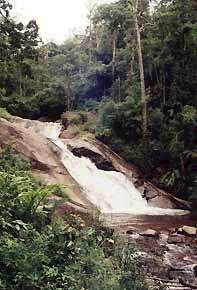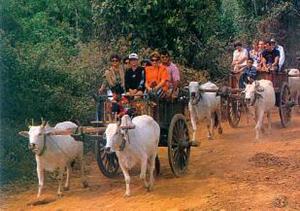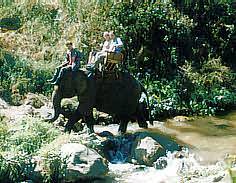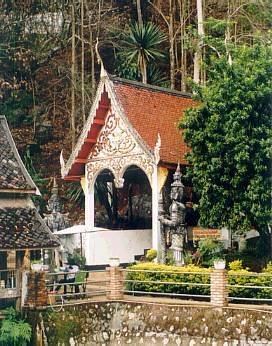
Window to Chiang Mai Thailand

Window to Chiang Mai Thailand
Elephant Care & Trekking Tours
Pai is a small Shan town on the Pai River in Mae Hong Son province. The temples are all in the Shan Burmese style, but there is also a strong Muslim community. Many wooden buildings remain in the town except in the more modern south-west corner. Picturesque scenery, languid atmosphere and easy access to hilltribe culture has made Pai a popular destination for budget travelers.
Trips out of Pai
See location at Google Maps: Pai
The small size of Pai makes it easy to walk around, but bicycles and motorcycles may be hired for taking trips further out.
See also:
Peaceful days in Pai
Elephant Camp
 (Office: 5/3 Moo 4, Rangsiyanon Road, Pai 58130. Elephant rides: 90 min. 500 THB per elephant. Longer rides and rafting trips available. Tel: 699286)
(Office: 5/3 Moo 4, Rangsiyanon Road, Pai 58130. Elephant rides: 90 min. 500 THB per elephant. Longer rides and rafting trips available. Tel: 699286)
The camp is located on the east side of the Pai River. The office in town also organizes other tours.
Mo Paeng Falls
Take the road past Pai Hospital to Shan and Lisu villages at the foot of the slopes on the west side of the valley. Tracks north-west along the foot of the mountains lead to the waterfall (8 km.). Alternatively, take the concrete road (H1095 KM.101 west turn - 4 km. 4WD for 1km.) that goes to Pai Mountain Lodge before becoming a track to the falls.
Wat Mae Yen & Tha Pai Hot Springs
If you go east across the river, you may walk to Wat Mae Yen (the temple on the hill). The route passes Pai's only public swimming pool (400 m. across the river. Hours 09:00-16:00. Adults 30 THB).
6 kilometers past the temple are the Tha Pai Hot Springs in a pleasant forested area.
North to Chiang Dao & Fang (H107)
Mae Malai - Chiang Dao
See location at Google Maps: Mae Malai
(Full Day. Chiang Dao Caves. Round trip 154 km. Regular buses to Fang make destinations on roads easy by public transport)
At KM.54 the road and the Ping River twist and turn through a gorge up to the rice basin of Chiang Dao. Although only the third highest mountain in Thailand, the limestone peaks of Doi Luang Chiang Dao are the most striking formation in the north.
Extensive caves lie at the foot of the east side. The uplands north and west of the mountain are popular trekking areas.
Mae Ngat Dam & Sri Lanna National Park
(H107 KM.41 east turn - 12 km.)
The flat valley of the Ping River in the Mae Ngat Dam area is a picturesque mix of villages, temples and rice fields.
At the north end of the L-shaped dam there are some local restaurants. Boats will take you for a pleasant thirty minute journey along the lake through the Sri Lanna National Park to some rafts (access only by boat. Accommodation available. Round trip 200-250 THB). The Sri Lanna National Park HQ is located just to the north of the dam. A scaled road from south of the dam (R1323) to the east leads to H1001 (Chiang Mai - Phrao).
Wat Tung Luang
(KM.42 West turn through ornamental gate just before the road climbs. Keep left at fork or go right to see a less interesting chedi. 2.5 km.)
This temple is brightly decorated in honor of Khru Ba Thammachai, who died in 1988 at the age of 73. The ubosot is lined with wood and the older viharn is no less ornate (sums given by various donors are clearly written on the part they donated to the temple).
The viharn itself contains a very life-like wax effigy of the monk. The final, macabre touch is a view of the Venerable's body through a mirror above a glass-topped coffin to the right.
Mae Taeng Valley Elephant Camps
See location at Google Maps: Mae Taeng
(KM.43 east turn - 10 km. and on. Personal transport necessary if not on tour)
A sealed road goes east for ten kilometers to some elephant camps.
These camps are usually booked through Chiang Mai agents. Beyond the camps, the road becomes a rough track (4WD) that follows the river in a steep valley to Ban Sop Kai (24 km.) and beyond.
Elephant Nature Park & Safari
 KM.10. Walk in price (410 THB) includes one-hour show (show starts 10 A.M. only) one-hour elephant ride, buffet lunch, ox-cart ride and rafting trip on Mae Taeng River.
KM.10. Walk in price (410 THB) includes one-hour show (show starts 10 A.M. only) one-hour elephant ride, buffet lunch, ox-cart ride and rafting trip on Mae Taeng River.
Mae Taman Rafting
KM.10 Elephant ride, ox-cart ride and rafting (450 THB per person with reductions for more than 2 persons). Elephant Show 9:30 only Tel: 297060
Mae Taeng Tour
18 km. 4WD. booking through agents only. Remote elephant camp in spectacular location.
 Tang Dao Elephant Training Center
Tang Dao Elephant Training Center
(H107 KM.56 Shows 09:00 & 10:00. 120 THB per person. One-hour elephant ride 800 THB per elephant. Rafting 45 min. 500 THB for two persons. Tel: 053298553)
This was the first elephant camp to be set up in the region. The camp is in a pretty location under trees on the river. A longer 90 minute elephant ride includes a trip to a set up "Lisu village".
You also can book a tour with Window to Chiang Mai Tours & Trekking
Chiang Dao
See location at Google Maps: Chiang Dao
 (KM. 72) Views of Doi Luang Chiang Dao are continuous after the road leaves the gorge that separates Chiang Dao from Chiang Mai. The valley contains ancient settlements and was reputed to be a place to which "bewitched" people were banished over a century ago.
(KM. 72) Views of Doi Luang Chiang Dao are continuous after the road leaves the gorge that separates Chiang Dao from Chiang Mai. The valley contains ancient settlements and was reputed to be a place to which "bewitched" people were banished over a century ago.
The small wooden market town of Chiang Dao serves Lisu, Hmong, Akha and Palaung villagers in the mountains around. Go east past Wat Indra and across the river to get to see lowland villages. Rough dirt roads (4WD) lead to hilltribe villages on the low plateau beyond.
Caves and Wat Pa Plong
(KM. 72 west turn 5 km. & 7 km.)
There are five interconnected caves that make up the Tham Chiang Dao complex. They extend a long way into the mountain. Only a small part of the complex is possible to explore. Two of the caves, Tham Phra Non (360m) and Tham Suea Dao (540m), are illuminated by electric lights. The other three Tham Maa (765m), Tham Kaew (477m), Tham Naam (660m) can be explored with the aid of local guides with lanterns. There are numerous spectacular cave formations.
The sealed road past the caves leads to Wat Pa Plong, an active meditation center.
See also:
Doi Luang Chiang Dao
You also can book a tour with Window to Chiang Mai Tours & Trekking
Fang & Thaton
(Overnight. Chiang Mai - Thaton 166 km.)
H107 continues from Chiang Dao through forested upland country before dropping down into the long rural valley to Fang and Thaton. From Thaton travelers go to Doi Mae Salong by road or to Chiang Rai by boat along the Kok River. Doi Pahom Pok (2285 m.), the large mountain to the north-west of Fang is the second highest mountain in Thailand.
Naresuan Monument
(KM. 75 west turn on R1178 - 5 km.)
A chedi in a small park marks the spot where King Naresuan died of sickness in 1605 in an expedition defending the kingdom against a Burmese invasion.
Phrao
See location at Google Maps: Phrao
(KM.83 east turn on R1150 - 31 km.)
The road goes along a pretty route that winds through the low jagged range that separates the Vale of Phrao from Chiang Dao.
Tap Tao Caves
(KM. 118 west turn - 3 km.)
Two large caves contain many Buddha images. The northern cave penetrates the mountains deeply in an upward direction. A path with steps and ladders goes into the cave for over a kilometer.
Humidity and harmless beasts such as wood-lice, cave pythons, and bats test the will of visitors who want to see the primitive Buddha images formed from stalagmites.
Doi Ang Khang
(KM. 138 west turn on R1249 - 26 km.)
The road climbs to the summit ridge very steeply (be careful when descending), continuing to an agricultural station specializing in temperate fruits and flowers and the Nature Resort. Temperatures get very low at night in the upland valley during the cold season. A road along the ridge to the north goes to a Palaung village and army frontier fort, which you can visit. The route then (motorcycles only) drops sharply down into the Fang valley.
Fang National Park
(KM. 149 west turn - 10 km.)
Hot springs dot the landscaped garden, but the pipes taking off hot water to the geothermal power station nearby have spoiled the ambiance of the site. A former periodic geyser no longer erupts, but there is a steam room and warm pool.
Fang
See location at Google Maps: Fang
(KM. 150)
King Mangrai made his capital here in 1268 before he captured Haripunchai (Lamphun) in 1281.
Today the border location gives the town a slightly wild feeling. The town serves as a market for nearby hilltribes as well as for unofficial visitors from the Shan State.
Thaton
See location at Google Maps: Thaton
(KM. 166)
The Kok River flows out from the Shan States in Myanmar into the wide Fang Valley at Thaton. It is the start for rafting-trekking trips down the river to Chiang Rai and the trip by road to Doi Mae Salong.
Wat Thaton overlooks the town and offers fine views from the hills above the main buildings. The temple contains some unusual images and structures, and there are plans to build a 45 meters high chedi. The temple offers meditation courses and short tours.
Phrao (H1001)
(Full day. Round trip via Chiang Dao 207 km.)
H1001 to Phrao (93 km.) passes through pleasant rural scenery. In truth, Phrao does not have any special tourist sights. But because it has a long history as a remote wiang in a substantial valley isolated by geography, its people and their ways truly represent the northern Thai. From Phrao an easy 31 kilometer run along R1150 to Chiang Dao goes on a picturesque route that joins with H107 at KM.83.
Bua Thong Falls
(KM.48 south-east turn - 3 km.)
A dirt road leads to a cave temple and waterfall. Both these places classify as small out-of-the way spots. Before the falls, a short track to the left leads to a spring known as the seven colors (rainbow) spring.
Wat Mae Pang
See location at Google Maps: Wat Mae Pang
(KM. 76)
In the Vietnam war, pilots reported seeing a monk flying in the clouds in the area. The monk was thought to be Luang Phu Wen Suchindo who died in 1985 at the age of 98. The legend led to the development of the temple. New temple buildings in the grove break with traditional designs.
Sri Lanna Falls
See location at Google Maps: Sri Lanna Falls
(H1001 KM. 79 west turn - 18.5 km. 4WD. Take a picnic and allow a day for this)
A degraded sealed road leads past a small dam and lake. It then becomes unsealed and increasingly steep as it climbs through a lovely cool evergreen forest.
The village of Men Hin Lai at the summit cultivates tea trees to produce miang, a leaf chewed with condiments.
The waterfall and a fine outlook over the Phrao Valley lies at the eastern end of an orchard and pasture in front of the village. Upland walking beyond the tea plantation looks interesting, but taking a village guide would be advisable.
Phrao
See location at Google Maps: Phrao
(KM.93)
Phrao is a small market town with one single main commercial street.
The town has a long history. Its remoteness allowed it to serve as a refuge during the late 18th century when Chiang Mai was abandoned.
R1150 to Wiang Papao is unsealed and offers an alternative route to Chiang Rai that passes through Lisu villages. (53 km. All-weather but 4WD, advised)
Trips out of Phrao
Doi Nang Lae
(North - 4 km.)
A narrow concrete lane continues north from the main commercial street to Doi Nang Lae. The "Dhamma Treatment Place" is guided by Nikhon Thammawathee, who became embroiled in a scandal when a follower accused him of fathering her child when he was a monk. Since the scandal the center has been quiet and the ex-monk eventually lost his case in the courts. The center has buildings and statues in a strange mix of Chinese and Indian styles.
Wat Son Pong in the village near the foot of Doi Nang Lae has also been decorated in a style that suggests large endowments.
Wat Phra Chao Lan Thong & Wat Tham Dok Kham
(R1150 KM.26 down dirt track going south - 600 m., or on scaled country lane from the south-west corner of the town).
Wat Phra Chao Lan Thong contains a Lanna Buddha image cast in 1527. The hill on which the temple is located is part of an old Thai Yuan settlement enclosed by earthen walls.
Remains of these may be seen on the approach to the temple. From Wat Phra Chao Lan Thong a sealed lane leads due south through villages. After 3 kilometers a west turn on a dirt road leads to the small cave temple of Wat Tham Dok Kham (take the right fork after 1 km.).
Sightseeing Guide
Pai, Chiang Dao, Fang, Thaton & Phrao